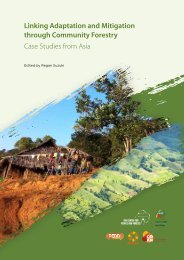Desktop Study on - Regional Climate Change Adaptation ...
Desktop Study on - Regional Climate Change Adaptation ...
Desktop Study on - Regional Climate Change Adaptation ...
Create successful ePaper yourself
Turn your PDF publications into a flip-book with our unique Google optimized e-Paper software.
<str<strong>on</strong>g>Desktop</str<strong>on</strong>g> <str<strong>on</strong>g>Study</str<strong>on</strong>g><br />
Table_13 Overview <strong>on</strong> natural disasters in Cambodia<br />
from 1980 to 2009<br />
Water Sector<br />
Top 5 Natural Disasters in Cambodia for the period 1980-2009<br />
Type of natural<br />
disaster<br />
Date/year<br />
Drought Jun 1994 5,000,000<br />
Flood Jul 2000 3,448,053<br />
Flood Aug 2001 1,669,182<br />
Flood Aug 2002 1,470,000<br />
Flood Sep 1996 1,300,000<br />
Total Natural Disasters in Cambodia for the period 1980-2009<br />
Type of<br />
natural<br />
disaster<br />
Total no of<br />
events<br />
No of<br />
people<br />
affected<br />
Storm 2 34,300 10<br />
dry seas<strong>on</strong>s (-54 to +35%) (Mac Sweeney et al., 2008<br />
cited in Roth, 2009). Another research anticipates<br />
greater temperature rise by about 2.3 to 2.8°C<br />
(Lacombe, 2009 cited in Roth, 2009). It also projects<br />
a reducti<strong>on</strong> in total rainy days and a decrease in<br />
dry seas<strong>on</strong> rainfall, interpreting it as a wetter rainy<br />
seas<strong>on</strong> with increase in intense rainfall events and<br />
resulting flood hazards. This study further predicts<br />
shifting of the average <strong>on</strong>set and end of the rainy<br />
seas<strong>on</strong> by about two days every 10 years.<br />
The projecti<strong>on</strong> focused <strong>on</strong> the sub-basins of the<br />
Mek<strong>on</strong>g River Basin shows that annual precipitati<strong>on</strong><br />
al<strong>on</strong>g the Tônlé Sap catchment areas is most likely<br />
to increase in a range of 200-300 mm, leading to the<br />
a decline of the eastern Kratie catchments (Eastham<br />
et al., 2008 cited in Roth, 2009). Although this trend<br />
is expected to occur in wet seas<strong>on</strong>s, a small median<br />
decrease- about -10 to -14 mm- in dry seas<strong>on</strong> rainfall<br />
is projected in 2030. The lower Mek<strong>on</strong>g, including the<br />
whole area of Cambodia, temperature is predicted to<br />
increase by 0.7°C to 0.8°C in 2030 compared to the<br />
1951-2000 baselines.<br />
CLIMATE CHANGE<br />
IMPACTS, VULNERABILITY<br />
AND ADAPTATION<br />
No of people<br />
affected<br />
Damage<br />
000 US$<br />
Drought 5 6,550,000 138,000<br />
Flood 13 9,533,614 328,100<br />
Epidemic 9 417,938 -<br />
Source: EM-DAT (2009): The OFDA /CRED; Internati<strong>on</strong>al Disaster Database; www.emdat.net<br />
- Université Catholique de Louvain – Brussels, – Belgium. Created <strong>on</strong>: Dec-23-<br />
2009. - Data versi<strong>on</strong>: v12.07<br />
108<br />
Range of Studies<br />
Reviewed and Methods<br />
Applied<br />
Most of the assessments of climate<br />
change projecti<strong>on</strong>s employed<br />
in this report rely <strong>on</strong> Global<br />
Circulati<strong>on</strong> Model (GCM). Eastham<br />
et al. (2008) selected 11 GCMs to<br />
build the year 2030’s scenarios<br />
of temperature and precipitati<strong>on</strong><br />
for the IPCC A1B scenario. The<br />
potential impacts of sea level rise in<br />
the coastal areas were c<strong>on</strong>ducted<br />
through Geographical Informati<strong>on</strong><br />
System (GIS) techniques. The<br />
methodologies for assessing<br />
provincial vulnerability to flood<br />
and drought are not indicated in<br />
the referred study.<br />
The Water and Development<br />
Research Group of Helsinki<br />
University of Technology (TKK)<br />
and the Southeast Asia START<br />
Regi<strong>on</strong>al Center (SEA START RC)<br />
analyses the hydrological impacts<br />
of climate change as well as<br />
related adaptati<strong>on</strong> strategies in the Tônlé Sap area<br />
of Cambodia (2009). The hydrological impacts of<br />
climate change were projected for the period between<br />
2010 and 2049 based <strong>on</strong> two main phenomena: 1)<br />
changed basin hydrology due to climate changeinduced<br />
changes in temperature and rainfall, and 2)<br />
sea level rise. For this study, high resoluti<strong>on</strong> future<br />
climate projecti<strong>on</strong> data was simulated for the 21st<br />
Century through the PRECIS regi<strong>on</strong>al climate model<br />
that employed as input dataset from ECHAM4 Global<br />
Circulati<strong>on</strong> Model under two different climate<br />
scenarios (A2 and B2), and downscaled it for the<br />
Mek<strong>on</strong>g Regi<strong>on</strong>.<br />
The Nati<strong>on</strong>al Adaptati<strong>on</strong> Program of Acti<strong>on</strong> (NAPA)<br />
and the Initial Nati<strong>on</strong>al Communicati<strong>on</strong> (INC)<br />
indicate the Level of vulnerability to flood and<br />
drought by province and recommended adaptati<strong>on</strong><br />
strategies. The local-level aut<strong>on</strong>omous and planned<br />
adaptati<strong>on</strong> practices are also touched up<strong>on</strong>.<br />
Impacts <strong>on</strong> the Water Sector<br />
Many researchers see increase in frequency and<br />
severity of flooding as a primary impact of climate

















